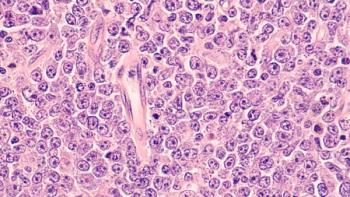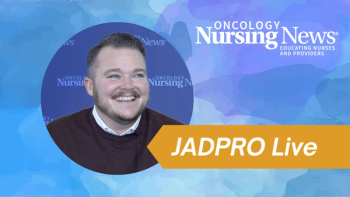
Lenalidomide Offers Patients With Smoldering Myeloma Option to Prevent Progression
Lenalidomide (Revlimid) significantly reduced the risk for smoldering multiple myeloma to progress to cancer among patients with moderate to high risk, according to findings from the phase II/III E3A06 trial to be presented at the 2019 ASCO Annual Meeting.
Lenalidomide (Revlimid) significantly reduced the risk for
“It is pretty clear that we need to differentiate treatment of myeloma versus prevention of smoldering to developing myeloma,” Sagar Lonial, MD, FACP, chief medical officer, Winship Cancer Institute of Emory University, said during a presscast held ahead of the meeting.
“That treatment or
Because many issues associated with multiple myeloma can result in irreversible morbidity and, at times, mortality — healthcare providers struggle to identify patients at high risk for progression and also how to intervene by risk stratification.
Therefore, in the randomized phase II/III trial, led by the ECOG-ACRIN Cancer Research Group and sponsored by the National Cancer Institute, the researchers evaluated efficacy and safety of lenalidomide compared with observation in patients with asymptomatic high-risk smoldering multiple myeloma to determine the reduction in risk and 2-year PFS associated with development of symptomatic disease.
In phase II of the trial — the run-in portion, according to Lonial – patients received 25 mg of oral lenalidomide once daily on days 1 through 21 for every 28-day cycle, as well as 325 mg of aspirin on days 1 through 28, until disease progression or unacceptable toxicity.
In phase III, 90 patients in the treatment arm received the same treatment regimen, while 92 patients in the control arm underwent observation until progression to symptomatic myeloma. Patients were stratified by the time since their smoldering multiple myeloma diagnosis.
At 3 years of follow-up, in 87% (phase II) and 91% (phase III) of patients with smoldering multiple myeloma receiving lenalidomide, the condition did not progress to cancer compared with 66% of people who underwent observation (phase III).
Overall, lenalidomide induced a 72% reduction in the risk for progression to symptomatic disease. Moreover, the time to develop multiple myeloma was delayed with lenalidomide [2-year progression-free survival (PFS): HR, 0.93; 95% CI, 0.88-0.99) compared with observation (2-year PFS: HR, 0.76; 95% CI, 0.66-0.87).
“We typically see two types of patients — those who are anxious and want to do something to prevent cancer from developing, and those who are more cautious and are willing to watch and wait,” Lonial said in a press release. “It’s gratifying to know that especially for the first group of patients there may now be a viable treatment option.”
While the researchers found a 72% reduction in the risk for progression of smoldering multiple myeloma to symptomatic disease with organ damage, they also discovered this benefit was consistent across low-, intermediate-, and high-risk groups — highlighting the potential for future study.
“What is really quite interesting is that each group appeared to benefit almost equally with early intervention with lenalidomide as a single agent, suggesting that while the high-risk group may be the group that we target now, this may be a fertile area for further investigation in the intermediate-risk group as well, which no trial has ever demonstrated benefit for the prevention of smoldering (disease) from developing into symptomatic myeloma,” Lonial said during the presscast.
In addition, he noted that about 50% of patients had an objective response to lenalidomide in both the phase II and phase II trial. Moreover, in the phase II portion of the study, 78% of the 44 patients enrolled did not progress to myeloma, with a median follow-up of over 5 years.
“With a similar-risk group of patients, one would expect that 50% to 60% of those patients would have converted to myeloma in that same time frame, suggesting that we would have prevented the development of organ damage and symptomatic myeloma in a large fraction of patients — not just in the randomized trial, but also in the smaller portion – and that is occurring with just some adverse events [AEs],” he added.
With this, the researchers observed hematologic and non-hematologic AE, including decreased neutrophil count, infections, dermatologic/skin effects, dyspnea, fatigue, hypertension, and hypokalemia. Grade 3 non-hematologic AEs occurred in 50% of patients and non-hematologic AEs in 52.3%, while 28.4% experienced non-hematologic treatment-related (TRAE)s and 35.3% with hematologic TRAEs.
While there were few Grade 4 AEs, Lonial noted the treatment was well-tolerated among patients.
“It is pretty clear that many of us would argue that early intervention with a prevention strategy — not a treatment strategy – can reduce the risk of conversion to symptomatic myeloma,” Lonial concluded.
ASCO president Monica M. Bertagnolli, MD, FACS, FASCO, highlighted the importance of these findings for patients with smoldering multiple myeloma. “Living with the uncertainty of whether cancer will develop is very difficult, so it’s exciting to be able to tell patients at high risk of multiple myeloma that they can take a pill to prevent or delay cancer,” she said. “This approach is not for everyone, however, because it comes with potentially heavy side effects and costs, so watching and waiting still has clear advantages that every patient should discuss with their doctor.”
Reference
Lonial S, Jacobus S, Fonseca R, et al. E3A06: Randomized Phase III Trial of Lenalidomide Versus Observation Alone in Patients With Asymptomatic High-Risk Smoldering Multiple Myeloma. Presented at: 2019 ASCO Annual Meeting Presscast; May 15. Abstract 8001.


















































































